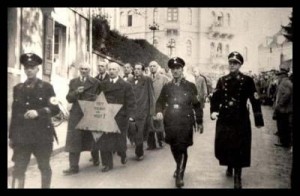Why is Kristallnacht seen as a turning point in the history of Nazi Germany?
9-10th November marks the 75th anniversary of Kristallnacht – night of the broken glass. What happened that night and why is it seen as a turning point in the history of Nazi Germany?
On the evening of the 9th November 1938, Jewish people living in Germany found themselves under attack. In a series of co-ordinated riots, over 7000 shops owned by Jews were destroyed and 200 synagogues were attacked. 90 Jews were killed that night. Thousands more were rounded up and sent to concentration camps. Why did this happen?
On 7th November a young German diplomat Ernst vom Rath was killed by Herschel Grynszpan in Paris. Grynszpan was Jewish. This murder, Joseph Goebbels claimed, led to a “spontaneous” outpouring of anger from the German masses. There was a feeling that Germans wanted to destroy perceived Jewish wealth and to remove their presence from the country. In fact, later evidence suggested that Grynszpan was set up and there was little spontaneity about the systematic and co-ordinated series of attacks which took place that night.
Kristallnacht was the latest in a series of acts of discrimination against the Jews. When Hitler came to power in 1933 he quickly introduced a boycott of Jewish businesses, whilst Jewish civil servants and teachers were dismissed from their jobs. Anti-Semitic lessons were introduced in schools. In 1935 the Nuremberg laws removed citizenship from Jewish Germans. It also forbade Germans from marrying Jewish people.
Kristallnacht was not, therefore, an isolated, “spontaneous” event. It did, however, mark a turning point in the lives of Jews in Germany. Previously, Jews had had their employment and civil liberties removed; this was outright violence. Kristallnacht showed that the Nazis intended to harm the Jewish people.
Between 1933-39, around half the Jewish population of Germany left the country. Following Kristallnacht, Jewish attempts to leave Germany dramatically increased. Jews applied for visas to other countries, but without money (their bank accounts had been frozen by the Nazis) they were often rejected. The international community realised this was serious and a meeting was convened at Evian, Lake Geneva. Whilst many delegates acknowledged that there was a problem in Germany, few countries wanted to get involved. American President Franklin D. Roosevelt refused to increase their immigration quota. The Australian delegate announced: “We have no race problem and we don’t want to import one”. After public pressure, Britain finally agreed to accept Jewish child refugees in a campaign known as kindertransport.
On the 70th anniversary of Kristallnacht in 2008, German chancellor Angela Merkel and Pope Benedict spoke out publicly about the horrific events of that night, and its sad significance. Kristallnacht was a turning point in history because it showed the violent aims Hitler had. Tragically, as we know, it did not mark the culmination of Nazi violence. Over the following seven years over six million Jews were systematically murdered by the Nazis. In the light of Kristallnacht there remains the sad question: could the world have done more?

